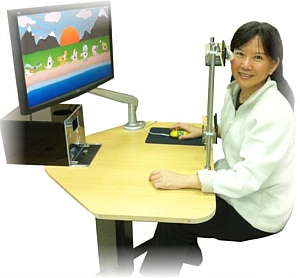Physicists at University of Tennessee Space Institute in Tullahoma developed a computer model to simulate human eye behavior for testing potential eye treatments. The system written by space institute physics faculty member Ying-Ling Chen (pictured left) aims to improve the efficiency and reduce the time needed by clinical trials involving human eyes.
Clinical trials of treatments for eye conditions are sometimes hampered by limited diversity and range of subjects, as a result of the extended time and expense of locating sufficient numbers for testing. Limited samples in trials can lead to uncertainty in the performance of new instruments to detect and diagnose a range of unusual eye conditions.
The simulation software, known as digital eye bank, takes data about the eyes of patients, and builds the data into models from the commercial optics programs used for tests conducted by researchers in their trials. The eye bank now stores data on 35 eyes with various demographics and conditions from the Wang Vision Center, a Lasik and laser cataract clinic in Nashville. This store of data can help refine the a research strategy before advancing to human clinical trials.
Another drawback of clinical trials on eyes is the limited ability to control for different types of eye conditions. With the digital eye bank, says Chen, operators can manipulate conditions encountered by the eye, such as opening it partially or rotating the pupil. Researchers using the eye bank can can also attach certain conditions to the eye data, such as growing a cataract or developing a tear duct issue. This feature allows operators to measure their instruments’ responses to these conditions.
The eye bank can also help plan surgery involving the eyes, such as predicting reactions to Lasik surgery and simulation of day and night vision after the procedure. “Today, it is also not well known on how the long-term outcome of new interventions would be,” says Chen. “But in the virtual world, we could induce cataract and dry eye and other aging conditions to predict the possible complicated outcomes and problems.”
The following video tells more about the eye bank.
- Study: Better Placebo Info Needed for Drug Trials
- Oracle Unveils Internet-Based Clinical Trial Services
- New Process Speeds Multiple Sclerosis Treatment to Trial
- Patent Awarded for Clinical Trial Molecular Matching System
* * *


 RSS - Posts
RSS - Posts
[…] Clinical Eye Testing Simulation Software Developed […]
[…] Clinical Eye Testing Simulation Software Developed […]